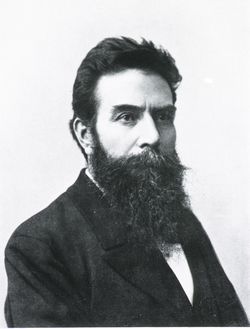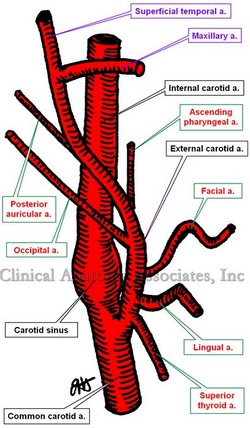
Medical Terminology Daily (MTD) is a blog sponsored by Clinical Anatomy Associates, Inc. as a service to the medical community. We post anatomical, medical or surgical terms, their meaning and usage, as well as biographical notes on anatomists, surgeons, and researchers through the ages. Be warned that some of the images used depict human anatomical specimens.
You are welcome to submit questions and suggestions using our "Contact Us" form. The information on this blog follows the terms on our "Privacy and Security Statement" and cannot be construed as medical guidance or instructions for treatment.
We have 794 guests online

Georg Eduard Von Rindfleisch
(1836 – 1908)
German pathologist and histologist of Bavarian nobility ancestry. Rindfleisch studied medicine in Würzburg, Berlin, and Heidelberg, earning his MD in 1859 with the thesis “De Vasorum Genesi” (on the generation of vessels) under the tutelage of Rudolf Virchow (1821 - 1902). He then continued as a assistant to Virchow in a newly founded institute in Berlin. He then moved to Breslau in 1861 as an assistant to Rudolf Heidenhain (1834–1897), becoming a professor of pathological anatomy. In 1865 he became full professor in Bonn and in 1874 in Würzburg, where a new pathological institute was built according to his design (completed in 1878), where he worked until his retirement in 1906.
He was the first to describe the inflammatory background of multiple sclerosis in 1863, when he noted that demyelinated lesions have in their center small vessels that are surrounded by a leukocyte inflammatory infiltrate.
After extensive investigations, he suspected an infectious origin of tuberculosis - even before Robert Koch's detection of the tuberculosis bacillus in 1892. Rindfleisch 's special achievement is the description of the morphologically conspicuous macrophages in typhoid inflammation. His distinction between myocardial infarction and myocarditis in 1890 is also of lasting importance.
Associated eponyms
"Rindfleisch's folds": Usually a single semilunar fold of the serous surface of the pericardium around the origin of the aorta. Also known as the plica semilunaris aortæ.
"Rindfleisch's cells": Historical (and obsolete) name for eosinophilic leukocytes.
Personal note: G. Rindfleisch’s book “Traité D' Histologie Pathologique” 2nd edition (1873) is now part of my library. This book was translated from German to French by Dr. Frédéric Gross (1844-1927) , Associate Professor of the Medicine Faculty in Nancy, France. The book is dedicated to Dr. Theodore Billroth (1829-1894), an important surgeon whose pioneering work on subtotal gastrectomies paved the way for today’s robotic bariatric surgery. Dr. Miranda.
Sources:
1. "Stedmans Medical Eponyms" Forbis, P.; Bartolucci, SL; 1998 Williams and Wilkins
2. "Rindfleisch, Georg Eduard von (bayerischer Adel?)" Deutsche Biographie
3. "The pathology of multiple sclerosis and its evolution" Lassmann H. (1999) Philos Trans R Soc Lond B Biol Sci. 354 (1390): 1635–40.
4. “Traité D' Histologie Pathologique” G.E.
Rindfleisch 2nd Ed (1873) Ballieres et Fils. Paris, Translated by F Gross
"Clinical Anatomy Associates, Inc., and the contributors of "Medical Terminology Daily" wish to thank all individuals who donate their bodies and tissues for the advancement of education and research”.
Click here for more information
- Details
The root term [-lapar-] term is Greex, and although today we use it to mean "abdomen", it actually means "flank" or "loins".
In its pure etymological meaning the root term [lapar], as in "laparotomy" or "laparoscopy" should be used to denote a surgical action in only two of the abdominal regions, the right and left lumbar regions (or flank regions) denoted in the accompanying image.
The first use of the term [-lapar-] referring to the whole of the abdominal region was in January, 1878 by Thomas Bryant, FRCS in his book "A Manual for the Practice of Surgery" using the term [laparotomy] to describe an "incision in the abdomen". Other terms used to denote the abdominal region are "ventral", and of course, "abdominal".
- Laparotomy: the suffix [-otomy] means to "open" or "to cut", the term means then " to cut of to open the abdomen"
- Laparoscope: an instrument used to view into the abdomen
- Laparoscopy: the act of using a laparoscope
- Laparostomy: an unusual procedure where the abdomen is not closed, but left partially open (but protected) so that the surgeon can come back periodically to perform an abdominal "lavage" to manage an intractable abdominal sepsis
- Laparorrhaphy: the suffix [-orrhaphy] means "to repair". Refers to the repair or closure of a laparotomy
Sources:
1. Mughal, M. M., Bancewicz, J. and Irving, M. H. (1986), ‘Laparostomy’: A technique for the management of intractable intra-abdominal sepsis. Br J Surg, 73: 253–259
2. Thomas, B.(1878). "A Manual for the Practice of Surgery" PHiladelphia: Henry C. Lea and Sons
- Details
The etymology of this word arises from two Latin words; [cribrum], meaning "a sieve" and [forma], meaning "shape" or "shaped-like". The word [cribriform] means then "sieve-like" or "perforated with a large number or holes".
There are places in the body where the term applies. Examples are the cribriform plate (lamina cribrosa), a sieve-like region found in the superior aspect of the ethmoid bone (see accompanying image) , described in detail by Gabrielle Fallopius. The olfactory nerves, extensions of the olfactory, bulb pass through the cribriform plate on their way to the olfactory epithelium, an area of the mucosa in the superior aspect of the nose. Another is the cribriform fascia (Hesselbach's fascia) on the anterosuperior aspect of the thigh through which passes the greater saphenous vein and other structures.
For more information on the ethmoid bone click here
Source:
1. "Anatomy of the Human Body" Henry Gray 1918. Philadelphia: Lea & Febiger
2 "Tratado de Anatomia Humana" Testut et Latarjet 8 Ed. 1931 Salvat Editores, Spain
Original image in the public domain, by Henry VanDyke Carter, MD, courtesy of bartleby.com
- Details
From the Latin [vena], meaning "vein". Some early authors postulated that the term derivates from the Latin word [venio] meaning "to come", because the blood in the veins "comes in" to the heart. There are two root terms meaning "vein", the first is the Latin derivated [-ven-], as in the terms venous and intravenous. The second root term is Greek [-phleb-], as in the terms phlebectomy, phlebotomy, and phlebotomist. Peripheral veins have internal one-way valves, while most of the central veins (in the trunk) do not present with valves. Failure of a peripheral venous valve can lead to dilation of the vein, condition called a varix.
- Venous: pertaining to a vein
- Intravenous: inside or within a vein
- Phlebectomy: removal of a vein
- Phlebotomy: to open a vein
- Details
The term [carotid] is Greek and means "to sleep", "to stupefy", or "to put to sleep". This arises from the observed fact that compression of the large arteries in the neck caused animals to fall asleep (Rufus of Ephesus c.100BC). Andrea Vesalius proposed the name "soporalis arteriae", but the Greek term [carotid] is what we use today.
The carotid arterial system is bilateral. On the right side, the right common carotid artery arises from the brachiocephalic trunk, while on the left side the left common carotid artery arises from the aortic arch. The common carotid artery divides into an external and an internal carotid artery. The internal carotid artery presents a dilation close to its origin, the carotid sinus, and then heads superiorly to enter the carotid canal of the temporal bone. The internal carotid artery does not give any branches in the neck region and ends providing important branches to the eye and the arterial circle of Willis, which supplies part of the brain.
The external carotid ends giving origin to two arteries, the superficial temporal artery and the maxillary artery. The external carotid artery gives off six named branches:
• Superior thyroid artery
• Lingual artery
• Facial artery
• Ascending pharyngeal artery
• Occipital artery
• Posterior auricular artery
Sources:
1. "The ancient Hellenic and Hippocratic origins of head and brain terminology" Panourias IG, et al Clin Anat 2012 Jul;25(5):548-581
2. "The origin of Medical Terms" Skinner, AH, 1970
Images property of: CAA.Inc. Artist: Dr. E. Miranda
- Details
This article is part of the series "A Moment in History" where we honor those who have contributed to the growth of medical knowledge in the areas of anatomy, medicine, surgery, and medical research.

Prof. Wilhem-Conrad Roentgen
Wilhelm Konrad Roentgen (1845 - 1923). A German physicist, Professor Roentgen started studying Physics at the University of Ultrech, and receiving his degree from the University of Zurich. Having observed fluorescence on a paper covered with barium platinocyanide close to an active cathode ray. Suspecting the presence of "invisible rays", he devised an experiment to prove this.
On November 8, 1895 he confirmed his theory and called these invisible-to-the-eye emissions "X"-rays. He also observed the action of these "X"-rays on photographic plates, and that these rays could traverse through the human body, showing the bones. In fact, the first "roentgenogram" was an image of his wife's hand. If you hover over Professor Roentgen's image, you will see an depiction of this historic image. This image marks the beginning of the science of Radiology.
Professor Wilhelm Konrad Roentgen received many awards, medals, and recognitions. In 1901 he was awarded the Physics Nobel Prize.
Sources:
1. http://www.nobelprize.org
2. "The origin of Medical Terms" Skinner, HA; 1970
Both original images (1) and (2) are in the public domain and courtesy of the National Library of Medicine.
Thanks to Megan Ohse for suggesting this article
- Details

Sulcus/gyrus and brain, lateral view
These two different terms must be analyzed together. The Latin term [sulcus] means "groove or fissure". Its plural form is [sulci]. There are many anatomical sulci in the body, one of them being the costal sulcus in the ribs.
The second term [gyrus] is also Latin and means "circle or ring", as used in the words gyroscope or gyrations. In its adjective or descriptive form, [gyrus] is used to denote something "bent, curved, or broad-shouldered"1. The plural form is [gyri]. In the case of the brain a gyrus is formed as a mound or an elevation between the "valleys" of the sulci (see image). If you click on the image a secondary image depicting the lateral aspect of the brain will appear.
In the brain there are many sulci, the secondary image shows the lateral or Sylvian sulcus, and the central sulcus or sulcus of Rolando.
In relation to the central sulcus there are two gyri. The anteriorly situated precentral gyrus is considered the primary motor cortex and associated with voluntary motor activity (colored in green in the secondary image). The postcentral gyrus (colored in blue) is situated posterior to the central sulcus and is the primary sensory cortex, associated with somatic (bodily) conscious sensation.
Sources:
1. "The Origin of Medical Terms" Skinner, HA 1970 Hafner Publishing Co.
2. "Medical Meanings - A Glossary of Word Origins" Haubrich, WD. ACP Philadelphia
3 "Tratado de Anatomia Humana" Testut et Latarjet 8 Ed. 1931 Salvat Editores, Spain
4. "Anatomy of the Human Body" Henry Gray 1918. Philadelphia: Lea & Febiger
Initial image by:Albert Kok,courtesy of:Wikipedia.org. Second image modified from the original image by Henry Vandyke Carter, MD., courtesy of bartleby.com
Terms suggested by Sara Mueller.




